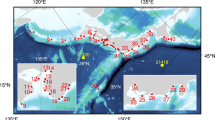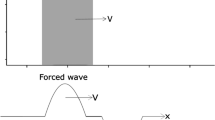Abstract
Tsunami-HySEA model is used to simulate the Caribbean LANTEX 2013 scenario (LANTEX is the acronym for Large AtlaNtic Tsunami Exercise, which is carried out annually). The numerical simulation of the propagation and inundation phases is performed with a single integrated model but using different mesh resolutions and nested meshes. Special emphasis is placed on assessing the most exposed coastal areas at Puerto Rico affected by this event. Some comparisons with the MOST tsunami model available at the University of Puerto Rico (UPR) are made. Both models compare well for propagating tsunami waves in open sea, producing very similar results. In near-shore shallow waters, Tsunami-HySEA should be compared with the inundation version of MOST, since the propagation version is limited to deeper waters. For inundation, larger differences between model results are observed. Nevertheless, the most striking difference resides in computational time; Tsunami-HySEA is coded using the advantages of GPU architecture, and can produce a 4 h simulation in a 60 arc-sec resolution grid for the whole Caribbean Sea in less than 4 min with a single GPU and as fast as 11 s with 32 GPUs. When details about the inundation must be simulated, a 1 arc-sec (approximately 30 m) inundation resolution mesh covering all of Puerto Rico, an island with dimensions of 160 km east–west and 56 km north–south, is used, and a three-level nested meshes technique implemented. In this case approximately 8 ¾ h of wall clock time is needed for a 2-h simulation in a single GPU (versus more than 2 days for the MOST inundation, running three different parts of the island—West, Center, East—at the same time due to memory limitations in MOST). When domain decomposition techniques are finally implemented by breaking up the computational domain into sub-domains and assigning a GPU to each sub-domain (multi-GPU Tsunami-HySEA version), we show that the wall clock time significantly decreases, allowing high-resolution inundation modeling in very short computational times, reducing, for example, if eight GPUs are used, the wall clock time to around 1 ½ h. Besides, these computational times are obtained at a modest hardware cost compared with present tsunami models.
















Similar content being viewed by others
References
Arce-Acuña, M., & Aoki, T. (2010). Real-time tsunami simulation solving the shallow water equations on multi-node GPU cluster. In ETHZ—Tokyo tech workshop: computing with GPUs, cells, and multicores, ETH Zurich, Switzerland, May 10, 2010.
Behrens, J. (2008). TsunAWI-unstructured mesh finite element model for the computation of tsunami scenarios with inundation, 5. NAFEMS CFD-seminar: “Simulation komplexer Strömungsvorgänge (CFD)—Anwendungen und Trends”.
Brodtkorb, A. R., Hagen, T., Lie, K.-A., & Natvig, J. (2011). Simulation and visualization of the Saint-Venant system using GPUs. Computing and Visualization in Science, 13, 341–353.
Brodtkorb, A. R., Satra, M. L., & Altinakar, M. (2012). Efficient shallow water simulations on GPUs: Implementation, visualization, verification, and validation. Computers and Fluids, 55, 1–12.
Castro, M. J., Chacón, T., Fernández-Nieto, E. D., González-Vida, J. M., & Parés, C. (2008). Well-balenced finite volume schemes for 2D non-homogeneus hyperbolic systems. Applications to the dam break of Aznalcóllar. Computer Methods in Applied Mechanics and Engineering, 197(45), 3932–3950.
Castro, M. J., Ferreiro, A., García, J. A., González, J. M., Macías, J., Parés, C., et al. (2005). The numerical treatment of wet/dry fronts in shallow flows: Applications to one-layer and two-layer systems. Mathematical and Computer Modelling, 42(3–4), 419–439.
Castro, M. J., González, J. M., & Parés, C. (2006). Numerical treatment of wet/dry fronts in shallow flows with a modified Roe scheme. Mathematical Models and Methods in Applied Sciences, 16(6), 897–931.
de la Asunción, M., Castro, M. J., Fernández-Nieto, E. D., Mantas, J. M., Ortega, S., & González-Vida, J. M. (2013). Efficient GPU implementation of a two waves TVD-WAF method for the two-dimensional one layer shallow water system on structured meshes. Computers and Fluids, 80, 441–452.
Dutykh, D., Poncet, R., & Dias, F. (2011). The VOLNA code for the numerical modeling of tsunami waves: Generation, propagation and inundation. European Journal of Mechanics-B, Fluids, 30(6), 598–615.
Gallardo, J. M., Parés, C., & Castro, M. J. (2007). On a well-balanced high-order finite volume scheme for shallow water equations with topography and dry areas. Journal of Computational Physics, 227, 574–601.
González-Vida, J. M., Macías, J., Castro, M. J., Sánchez-Linares, C., de la Asunción, M., Ortega-Acosta, S., Arcas, D. (2016). The Lituya Bay landslide-generated mega-tsunami. Numerical simulation and sensitivity analysis. Journal of Geophysical Research (submitted).
Imamura, F., Yalciner, A. C., Ozyurt, G. (2006). Tsunami modelling manual. UNESCO IOC international training course on Tsunami Numerical Modelling.
Intergovernmental Oceanographic Commission. (2012). Exercise Caribe Wave/LANTEX 13. A Caribbean Tsunami Warning Exercise, 20 March 2013. Volume 1: participant handbook. IOC Technical Series No. 101. Paris: UNESCO.
Kardos, J. (2013). Evaluating realistic tsunami simulations with SWE model on GPU-enable cluster. USI technical report series in informatics, USI-INF-TR-2013-3 (p. 8).
Liang, W.-Y., Hsieh, T.-J., Satria, M.T., Chang, Y.-L., Fang, J.-P., Chen, C.-C., Han, C.-C. (2009). A GPU-based simulation of tsunami propagation and inundation. In A. Hua, & S.-L. Chang (Eds.), ICA3PP 2009, LNCS (Vol. 5574, pp. 593–603).
Lynett, P. J., Gately, K., Nicolsky, D., Wilson, R, et al. (2016). Report on the 2015 NTHMP current modeling workshop, 9–10 Feb 2015, Portland, Oregon (p. 202) (to appear in Nov 2016).
Macías, J., Castro, M. J., González-Vida, J. M., de la Asunción, M., Ortega, S. (2014). Tsunami-HySEA: An operational GPU-based model for tsunami early warning system. Geophysical Research Abstracts (Vol. 16, EGU2014-14217).
Macías, J., Castro, M. J., González-Vida, J. M., Ortega, S. (2013). Non-linear shallow water models for coastal run-up simulations. EGU 2013.
Macías, J., Castro, M. J., Ortega, S., Escalante, C., González-Vida, J. M. (2015a). Tsunami-HySEA benchmark results. In NTHMP report of the mapping and modeling benchmark workshop, Portland, 9–10 Feb 2015.
Macías, J., Castro, M. J., Ortega, S., Escalante, C., González-Vida, J. M. (2016). NTHMP benchmarking of Tsunami-HySEA model for propagation and inundation. In The 2011 NTHMP model benchmarking workshop. Report submitted to the MMS of the NTHMP.
Macías, J., González-Vida, J. M., García, J., Castro, M. J., Ortega, S., de la Asunción, M. (2015b). HySEA model verification for Tohoku 2011 Tsunami. Application for mitigation tsunami assessment. European Geoscience Union General Assembly (EGU 2015).
Macías, J., Vázquez, J. T., Fernández-Salas, L. M., González-Vida, J. M., Bárcenas, P., Castro, M. J., et al. (2015c). The Al-Boraní submarine landslide and associated tsunami. A modelling approach. Marine Geology, 361, 79–95.
Mercado, A. (2014a). Report on Puerto Rico tsunami flood maps for local events. Puerto Rico Seismic Network.
Mercado, A. (2014b). Report on Puerto Rico tsunami flood maps for regional events. Puerto Rico Seismic Network.
Michelini, A. et al. (2014). Introducing CAT (Centro di Allerta Tsunami), the Italian candidate Tsunami Watch Provider (It-cTWP) for the Mediterranean. In Geophysical research abstract, (Vol. 16, EGU2014-15646).
NTHMP (2012). National Tsunami Hazard Mitigation Program. In Proceedings and results of the 2011 NTHMP model benchmarking workshop (NOAA special report) (p. 436). Boulder: US Department of Commerce/NOAA/NTHMP.
Okada, Y. (1985). Surface deformation due to shear and tensile faults in a half space. Bulletin of the Seismological Society of America, 75(1135), 1154.
Satria, M. T., Huang, B., Hsieh, T.-J., Chang, Y.-L., & Liang, W.-Y. (2012). GPU acceleration of tsunami propagation model. IEEE Journal of Selected Topics in Applied Earth Observations and remote Sensing, 5(3), 1014–1023.
Synolakis, C. E., Bernard, E. N., Titov, V. V., Kânoğlu, U., & González, F. I. (2008). Validation and verification of tsunami numerical models. Journal of Pure and Applied Geophysics, 165(11–12), 2197–2228.
ten Brink, U., Twichell D., Geist E., Chaytor J., Locat J., Lee H., Buczkowski B., Barkan R., Solow A., Andrews B., Parsons T., Lynett P., Lin J., and Sansoucy M. (2008). Evaluation of tsunami sources with the potential to impact the US Atlantic and Gulf coasts: An updated report to the nuclear Regulatory Commission. U.S. Geological Survey Administrative Report.
Titov, V., & Synolakis, C. (1998). Numerical modeling of tidal wave runup. Journal of Waterway, Port, Coastal, and Ocean Engineering, 124(4), 157–171.
Wang, X. (2009). User manual for COMCOT version 1.7 (first draft). http://ceeserver.cee.cornell.edu/pll-group/doc/COMCOT_User_Manual_v1_7.pdf. Accessed 29 Aug 2016.
Acknowledgments
This research has been partially supported by the Junta de Andalucía research project TESELA (P11-RNM7069), the Spanish Government Research projects DAIFLUID (MTM2012-38383-C02-01) and SIMURISK (MTM2015-70490-C02-01-R) and Universidad de Málaga, Campus de Excelencia Andalucía TECH. The tsunami work in Puerto Rico was supported by the USA National Tsunami Hazard Mitigation Program (NTHMP). Travel funds for Aurelio Mercado were provided by the Puerto Rico Seismic Network and the Faculty of Arts and Sciences of the University of Puerto Rico, Mayaguez, P.R. The GPU and multi-GPU computations were performed at the Unit of Numerical Methods (UNM) of the Research Support Central Services (SCAI) of the University of Malaga. Finally, we would like to thank the two anonymous reviewers for their useful comments and their detailed and careful reviews.
Author information
Authors and Affiliations
Corresponding author
Rights and permissions
About this article
Cite this article
Macías, J., Mercado, A., González-Vida, J.M. et al. Comparison and Computational Performance of Tsunami-HySEA and MOST Models for LANTEX 2013 Scenario: Impact Assessment on Puerto Rico Coasts. Pure Appl. Geophys. 173, 3973–3997 (2016). https://doi.org/10.1007/s00024-016-1387-8
Received:
Revised:
Accepted:
Published:
Issue Date:
DOI: https://doi.org/10.1007/s00024-016-1387-8




